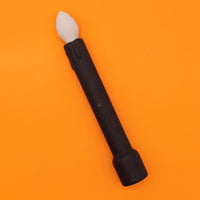Sam*, a 26-year-old heterosexual man, began having unreliable erections after starting on Lexapro, an antidepressant
in the SSRI family. After it happened a few times, he and his girlfriend tried to talk about it. “I kept reassuring her she wasn’t doing anything wrong, but I could tell she was thrown off,” Sam says. “Inevitably we both ended up feeling like shit every time we tried
.” He even considered going off the medication.
Erectile dysfunction can result from age, medical issues, pharmaceutical side effects, stress, performance anxiety, frequent porn usage … basically, everyday life in 2019 conspires to make erections less reliable. But the absence of a boner, in and of itself, doesn’t have to halt a couple’s sex life—it’s our insistence that erections are required to have great sex that ruins the party for everybody. “When I ask straight couples what they think sex is, PVI is the only answer,” says Dr. Rosara Torrisi. “It’s like nothing else exists.”
This pressure to perform fosters anxiety and self-esteem issues in penis-havers, and it’s not fair to their partners, either. Most people with vaginas don’t achieve orgasm from penetration alone, and the phallus-centric default of hetero sex means that all non-penetrative contact, or penetration with any number of non-penis objects and/or body parts, gets pushed out of the “sex” category and into the “foreplay” slot for no good reason. (The patriarchy’s continued influence on our collective sexual subconscious is not a good reason.)
While the LGBTQ community’s definition of sex is generally more fluid, this isn’t just an issue for heterosexual couples. This year, a survey of 2,000 men in the UK revealed that 56% of gay or bisexual men have experienced erectile dysfunction compared with 46% of heterosexual men. (Although it’s worth noting that this data was self-reported, and that only 150 of these men were non-heterosexual.) As a leading cause of ED, the non-hetero group ranked pressure to perform over drinking a few too many or experiencing side effects from medication—evidence that this mindset is toxic across lines of sexual orientation.
Channel a time in your sexual history before penetrative sex was the natural conclusion to physical attraction.
Laura*, 25, became aware of this bias after she was diagnosed with vulvodynia and pelvic floor dysfunction. She and her partner switched to outercourse, a.k.a. non-penetrative sex, after a sporadic history of painful PVI sex. “For the first time , I felt like we had a normal, healthy sex life,” Laura says. “But my friends were like, ‘Is it hard as a couple that you can’t actually fuck?’” She also noticed a dissonance in how she described it to them: “It was in that high school way of, ‘We do everything but,’”—even though she felt like they were having complete sexual experiences.
Here are some ideas on how to use the absence of an erection as an opportunity to explore all the hidden spots and side streets of each others’ bodies.
Build up the tension
Before you get going, start channeling a time in your sexual history before penetrative sex was the natural conclusion to physical attraction. To achieve this, try the Karezza technique, an exercise first published by a sex therapist in 1931, although the actual practice supposedly goes all the way back to 1844. You and your partner lie down together naked, with your genitals touching, for 30 minutes. Relax your body and breathe deeply. And… that’s it! The idea is to build arousal and anticipation, enjoying the skin-to-skin contact.
Reframe foreplay as a main event
Dry-humping is an excellent go-to, particularly for people with vulvas, and without an erection there are far fewer issues with chafing. Some fingering techniques your partner can try: First, there’s orbiting, circling around the clit with a fingertip, letting the blood flow build up to enhance the eventual orgasm. There’s also layering, a technique of working inward by first stroking the external areas of the vagina, like the vulva and labia majora.
Now it’s your partner’s turn to get the finger. Try muffing, a penile fingering technique first detailed in Mira Bellwether’s underground zine Fucking Trans Women. Find his inguinal canals, located in the groin “above and behind the testicles and scrotum.” Explore the area until you locate the entrances (they’re similar to a finger in diameter but do stretch), and gently, slowly penetrate them with your fingers.You could also perform an external prostate massage: Bring your pointer, middle, and ring fingers together, then push up into your partner’s perineum (the area between the scrotum and the anus, a red-hot zone for plenty of penis-owners). Rub clockwise for eight to ten strokes, then repeat counterclockwise.
Explore uncharted terrain—or old terrain in new ways
If you love to be penetrated digitally, the best position is you on top of your partner, facing upwards and leaning back. Penetration feels deepest from this angle.
This is also a great time to dip a toe—or a finger, or a tongue—into butt stuff. You both have the equipment to give and receive, whether that means anal fingering or diving right into rim jobs. (Just be sure not to follow any anal action up directly with oral-genital contact, as the resulting bacteria could disrupt the vagina’s delicate pH balance.)
Once a boner finds out that its attendance isn’t mandatory, it might just make a surprise appearance.
And you could try an internal prostate massage: Once you've got a well-lubed finger inside your partner’s anus (as well as an enthusiastic go-ahead), start moving it upwards in a "come here" motion towards the front of their body.
Treat yourself to some soft serve
An erection actually isn’t necessary for ejaculation and orgasm; with enough stimulation, penis-havers can come when partially erect or even fully flaccid. (The more you know!) With a little creative thinking, a flaccid penis can get you both where you need to go.
For instance, the sensation of a soft penis rubbing against your clit might feel amazing, especially if you’re someone who finds direct, intense pressure on your clit to be uncomfortable. With a lot of lube, titty fucking can be just as comfortable when flaccid. You could also enjoy some mutual masturbation. All of these activities serve up some voyeuristic eye candy for both of you; contrary to popular belief, studies show that men and women are equally turned on by erotic visuals.
“Sex is a balance of relational energy,” Torrisi says. “We get off on knowing our partner likes what we’re doing.” Try a small, yet important shift in focus: Instead of relying on an erection as the only signal of arousal—which puts psychological pressure on both of you—you’re retraining yourselves to accept that validation (and resulting arousal) from each others’ face and movements, which is significantly more intimate.
Take a trip to the (adult) toy store
If you’re craving penetration with something more sizeable than a finger, reach for a strap-on or dildo. You could treat it like a surrogate penis, or take turns using it if that’s something that turns you on. (Again, be sure to clean it thoroughly before transitioning from anal to vaginal use.) A finger vibrator can be used to great, teasing effect on both the male and female anatomy, including nipples and other sensitive areas. Your partner could be into trying a prostate stimulator, or a very well-lubed masturbation sleeve.
Here’s the ironic twist: Once a boner finds out that its attendance isn’t mandatory, it might just make a surprise appearance. That’s what happened to Sam after he and his partner made oral sex the mainstay of their sex life. But if it does happen, remember to think of PVI as a bonus, not something to rearrange your whole itinerary around. “As big as anyone’s penis is, it’s still a small part of the anatomy,” Torrisi says. “Our whole bodies can experience pleasure, and it’s a shame to miss out on that opportunity.”
It bothered Laura that her newfound sex life was reduced to the absence of one activity—which she’d never even enjoyed—so she changed how she talked about it. For instance, instead of defaulting to the “everything-but” narrative (He fingered me and then I went down on him last night), she started saying simply, We had sex last night. A small change, but more aligned with her truth, she says. “Nothing about what we do feels incomplete to me.”














































